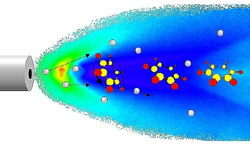Disk Molecule Flies Like a Frisbee

It’s not hard to toss a Frisbee in the right orientation, but imagine trying to throw a disk-shaped molecule that way. The 28 May PRL suggests that there is a way to align a beam of these molecules: Simply mix them with helium at high pressure, and release the gas through a nozzle. Collisions with the helium atoms automatically suppress the orientation a clown would use for a cream pie, say the researchers, and the largely edge-on molecules could then be used for detailed studies of organic chemical reactions, such as those important to industry. Although simpler, inorganic molecules have been oriented using similar techniques, this is the first demonstration that such a large, organic molecule can be aligned without using strong laser fields.
Atoms of a light gas like helium naturally travel a lot faster at a given temperature than heavier gas molecules like , , or CO. So when researchers “seed” helium with a few percent of and allow the mixture to blast out of a nozzle, the helium atoms pummel the larger molecules as the mixture passes out to the vacuum. molecules experience so many colliding atoms coming from a single direction that they become preferentially aligned in directions in which they take less of a beating. They tend to spin about an axis perpendicular to their direction of travel–doing cartwheels, rather than spinning like a propellor. A similar effect aligns logs floating down a river, says Richard Zare of Stanford University–you never see a log oriented perpendicular to the river flow.
Vincenzo Aquilanti and his colleagues at the Universities of Perugia and Trento in Italy wanted to see if the disk-shaped benzene would act similarly. “Benzene is the favorite target of organic chemists,” says Aquilanti, so he could imagine a wide range of applications for an oriented benzene beam. But benzene has no electric or magnetic character that can easily reveal the alignment. So the team performed two complementary experiments to look for the alignment of benzene: In the first experiment, they aimed a polarized infrared (IR) laser beam across the molecular beam and placed an IR detector on the far side. They chose a wavelength that is most easily absorbed by benzene when the light’s electric field is in the plane of the molecule’s disk. The researchers measured the degree of benzene’s IR absorption for both horizontal and vertical polarization (electric field orientation) of the laser light and found more Frisbee than cream pie orientations.
In the second experiment, the team sent the benzene beam through a velocity selector and into a chamber of neon or argon gas. Beyond the gas chamber was a detector, which allowed them to measure the cross section–the probability for benzene molecules to interact with gas atoms at each velocity. Since this probability is highly sensitive to the benzene molecule’s orientation, Aquilanti and his colleagues found more evidence of the beam’s alignment.
In the end, the team found 20%-30% more edge-on benzene molecules than would be expected for random orientations. But Aquilanti says that should be good enough to use the beam to look at the elementary steps in organic chemical reactions, where the orientation of the reactant molecules is often critical for the outcome. Although strong laser pulses can align certain molecules for very short times, Aquilanti’s method may be better suited to chemical reaction studies because the aligned beam is continuous.
”I’m delighted to see this,” says Zare, who recalls seeing aligned logs flow down a river as a child. “It’s always a pleasure to see that things that you understand on a macroscopic level have counterparts on the microscopic level.”


